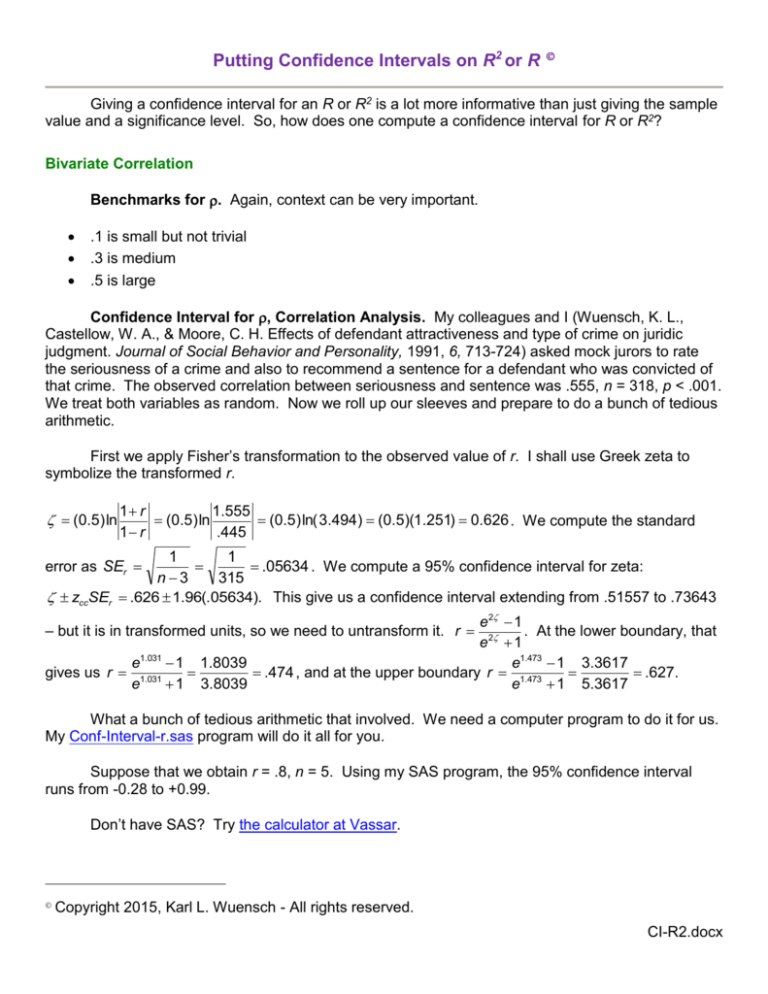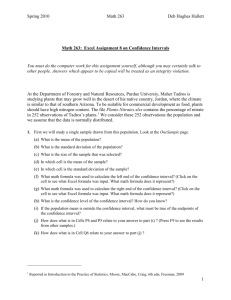
Putting Confidence Intervals on R2 or R
Giving a confidence interval for an R or R2 is a lot more informative than just giving the sample
value and a significance level. So, how does one compute a confidence interval for R or R2?
Bivariate Correlation
Benchmarks for . Again, context can be very important.
.1 is small but not trivial
.3 is medium
.5 is large
Confidence Interval for , Correlation Analysis. My colleagues and I (Wuensch, K. L.,
Castellow, W. A., & Moore, C. H. Effects of defendant attractiveness and type of crime on juridic
judgment. Journal of Social Behavior and Personality, 1991, 6, 713-724) asked mock jurors to rate
the seriousness of a crime and also to recommend a sentence for a defendant who was convicted of
that crime. The observed correlation between seriousness and sentence was .555, n = 318, p < .001.
We treat both variables as random. Now we roll up our sleeves and prepare to do a bunch of tedious
arithmetic.
First we apply Fisher’s transformation to the observed value of r. I shall use Greek zeta to
symbolize the transformed r.
(0.5) ln
1 r
1.555
(0.5) ln
(0.5) ln( 3.494) (0.5)(1.251) 0.626 . We compute the standard
1 r
.445
1
1
.05634 . We compute a 95% confidence interval for zeta:
n 3
315
zccSEr .626 1.96(.05634). This give us a confidence interval extending from .51557 to .73643
error as SEr
e 2 1
. At the lower boundary, that
e 2 1
e1.031 1 1.8039
e1.473 1 3.3617
gives us r 1.031
.474 , and at the upper boundary r 1.473
.627.
e
1 3.8039
e
1 5.3617
– but it is in transformed units, so we need to untransform it. r
What a bunch of tedious arithmetic that involved. We need a computer program to do it for us.
My Conf-Interval-r.sas program will do it all for you.
Suppose that we obtain r = .8, n = 5. Using my SAS program, the 95% confidence interval
runs from -0.28 to +0.99.
Don’t have SAS? Try the calculator at Vassar.
Copyright 2015, Karl L. Wuensch - All rights reserved.
CI-R2.docx
2
Confidence Interval for 2, Regression Analysis. If you consider your predictor variable to
be fixed rather than random (that is, you arbitrarily chose the values of that variable, or used the
entire population of possible values, rather than randomly sampling values from a population of
values), then the confidence interval for 2 is computed somewhat differently. The SAS program
Conf-Interval-R2-Regr can be employed to construct such a confidence interval. If you are using
SPSS, see CI-R2-SPSS at my SPSS Programs Page.
F= 20.91 ;
df_num = 2 ;
df_den = 48 ;
***************************************************************************************;
ncp_lower = MAX(0,fnonct (F,df_num,df_den,.95));
ncp_upper = MAX(0,fnonct (F,df_num,df_den,.05));
eta_squared = df_num*F/(df_den + df_num*F);
eta2_lower = ncp_lower / (ncp_lower + df_num + df_den + 1);
eta2_upper = ncp_upper / (ncp_upper + df_num + df_den + 1);
output; run; proc print; var eta_squared eta2_lower eta2_upper; run;
Obs eta_squared eta2_lower eta2_upper
1
0.46560
0.27247
0.57713
If you use the program above with F = t2 for the test of a partial correlation, it will return the
squared partial correlation coefficient and its confidence interval.
3
You can also use SAS PROC GLM to get confidence intervals for R2, sr2, and pr2.
proc glm data=Sage; model Cyberloafing = Conscientiousness Age / EFFECTSIZE ALPHA=.1;
Obs eta_squared eta2_lower eta2_upper
1
0.46560
0.27247
0.57713
The GLM Procedure
Proportion of Variation Accounted for
Eta-Square
0.47
90% Confidence Limits
(0.27,0.58)
Although the output says “Eta-Squared,” when the model is linear with no categorical
predictors the values are for R2, sr2 and pr2.
Source
DF
Type III (unique) Effect Sizes
Partial Variation Accounted For
Semipartial EtaSquare
Conservative
90% Confidence
Limits
Partial EtaSquare
90% Confidence
Limits
Conscientiousness
1
0.2521
0.0916
0.3993
0.3205
0.1423
0.4580
Age
1
0.1486
0.0272
0.2955
0.2176
0.0649
0.3630
Confidence Interval for 2, Correlation Analysis. Use R2, which is available for free, from
James H. Steiger and Rachel T. Fouladi. You can download the program and the manual here.
Unzip the files and put them in the directory/folder R2. Navigate to the R2 directory and run (double
click) the file R2.EXE. A window will appear with R2 in white on a black background. Hit any key to
continue. Enter the letter O to get the Options drop down menu. Enter the letter C to enter the
confidence interval routine. Enter the letter N to bring up the sample size data entry window. Enter
318 and hit the enter key. Enter the letter K to bring up the number of variables data entry window.
Enter 2 and hit the enter key. Enter the letter R to enter the R2 data entry window. Enter .308 (that is
.555 squared) and hit the enter key. Enter the letter C to bring up the confidence level data entry
window. Enter .95 and hit the enter key. The window should now look like this:
4
Enter G to begin computing. Hit any key to display the results.
As you can see, we get a confidence interval for R2 that extends from .267 to .610.
Hit any key to continue, F to display the File drop-down menu, and X to exit the program.
Bad News: R2 will not run on Windows 7 Home Premium, which does not support DOS. It
ran on XP just fine. It might run on Windows 7 Pro.
Good News: You can get a free DOS emulator, and R2 works just fine within the virtual DOS
machine it creates. See my document DOSBox.
More Good News: The programs that assume a regression model rather than a correlation
model give you confidence intervals that differ little from those given by R2.
The R2 program will not handle sample sizes greater than 5,000. In that case you can use the
approximation procedure which is programmed into my SAS program Conf-Interval-R2-RegrLargeN.sas. This program assumes a regression model (fixed predictors) rather than a correlation
model (random predictors), but in my experience the confidence intervals computed by R2 differ very
little from those computed with my large N SAS program when sample size is large (in the
thousands).
What Confidence Coefficient Should I Employ? When dealing with R2, if you want your
confidence interval to correspond to the traditional test of significance, you should employ a
confidence coefficient of (1 - 2α). For example, for the usual .05 criterion of statistical significance,
use a 90% confidence interval, not 95%. This is illustrated below.
Suppose you obtain r = .26 from n = 62 pairs of scores. If you compute t to test the null that
rho is zero in the population, you obtain t(60) = 2.089. If you compute F, you obtain F(1, 60) = 4.35.
The p value is .041. At the .04 level, the correlation is significant. When you put a 95% confidence
interval about r you obtain .01, .48. Zero is not included in the confidence interval. Now let us put a
confidence interval about the r2 (.0676) using Steiger & Fouladi’s R2.
5
Oh my, the confidence interval includes zero, even though the p level is .04. Now lets try a
90% interval.
That is more like it. Note that the lower limit from the 90% interval is the same as the “lower
bound” from the 90% interval.
Unstandardized Slopes
Standard computer programs will give you a confidence interval for the unstandardized slope
for predicting the criterion variable from the predictor variable. For example, in SAS: proc reg; a:
model ar = misanth / CLB; In SPSS, in the Linear Regression Statistics window, just remember to
ask for confidence intervals.
Multiple Correlation and Regression.
The programs mentioned above can be used to put confidence intervals on multiple R2 too.
They can also be employed to put a confidence intervals on squared partial correlation coefficients for
single variables or blocks of variables. I would prefer to use the squared semipartial correlation
coefficient (the amount by which R2 increases when a variable or block of variables is added to an
existing model). To convert pr2 to sr2 do this: srB2 prB2 (1 RY2.A ) where A is the previous set of
variables, B is the new set of variables, and Y is the outcome variable. For an example, see my
document Multiple Regression with SPSS .
6
CI for Every Correlation in a Matrix
If you desire to obtain a CI for every element of a correlation matrix, directly from the raw data,
check this out: An SPSS Macro to Compute Confidence Intervals for Pearson’s Correlation.
Karl L. Wuensch, June, 2015.
Fair Use of this Document
Confidence Intervals on Partial R2 and on Standardized Beta Weights
Proc GLM CI Less Conservative
Return to Wuensch’s Statistics Lesson Page








